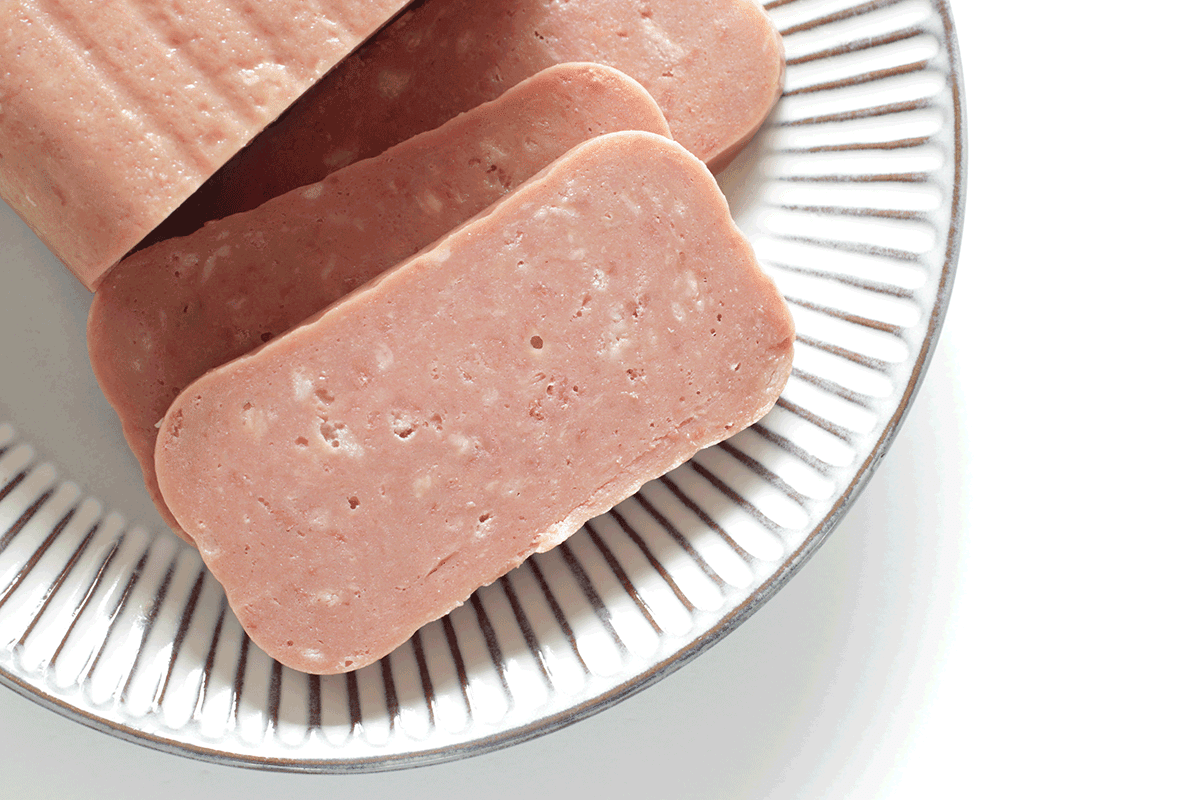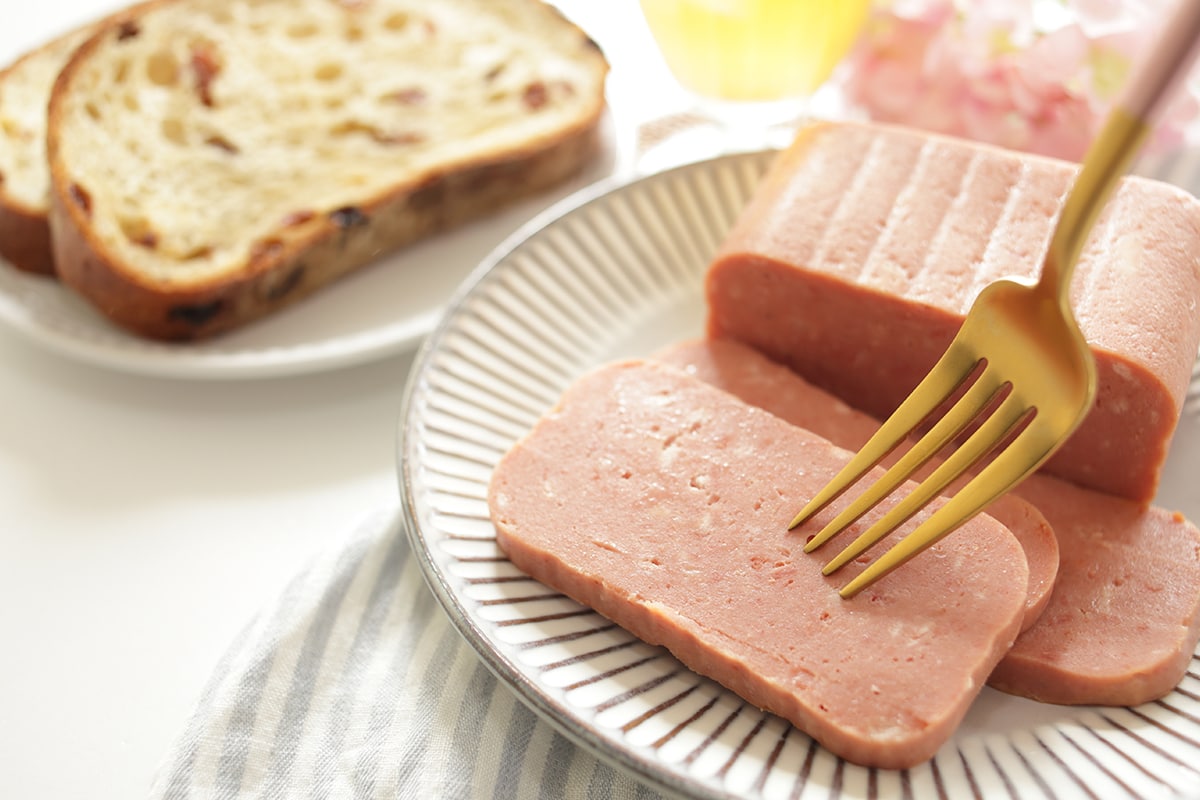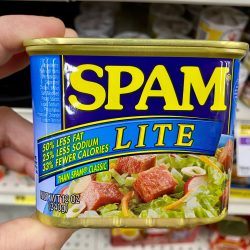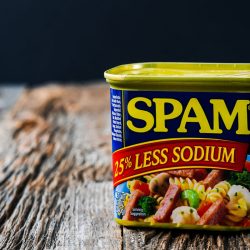There's no denying it: Spam is a salty food. While the high amount of sodium is necessary to preserve pork, it can be unpalatable in some recipes. Plus, people on a low-sodium diet may put off eating Spam due to its notorious salt concentrations. We've researched how to do just this, and here's what you need to know:
Although Spam will never be a superfood, there are ways you could reduce Spam's salt content. Here are a few of the top techniques for naturally removing salt from Spam:
- Place your Spam in boiling water for about 30 minutes before cooking it.
- Put Spam strips in cold water, let them sit for ~ 30 minutes, and drain.
- Wash your Spam with cool running water and pat dry.
- Incorporate more peeled potatoes into Spam recipes.
These simple strategies can significantly reduce the salt content in traditional Spam. There are also many alternative products and secondary ingredients that could make your Spam taste less salty. Please keep reading to learn how to kick excess sodium out of Classic Spam.
How to Make Spam Less Salty: Four Sensational Sodium Reduction Strategies
As long as you have a pot and some water, you can easily reduce the salt content in Spam. For the best results, plan to spend 30 extra minutes in the kitchen to get rid of Spam's saltiness.
1. Boil Spam Slices Before Cooking

Boiling your Spam is the most time-consuming way to remove salt, but it's arguably the most effective. Plus, it's not super difficult to follow this strategy.
Here's the basic technique for removing sodium from Spam via boiling:
- Put a pot of water on the stovetop over high heat.
- Take your Spam out of the container and cut it into slices.
- When the water is boiling, put your Spam slices in the pot and separate them.
- Keep your water on a rolling boil for 15 minutes.
- Shut off the heat and cover your pot for another 15 minutes.
- Pour your Spam into a strainer and run cool tap water over it.
- Keep rinsing your Spam till you notice the water is clear.
- Pat your Spam dry and either use it for cooking or preserve it in the fridge in cling wrap.
For a video explanation of how this method works, be sure to check out this video:
2. Soak Your Spam In Cool Water
If you don't have the time to stand by a boiling pot, there's good news: you can remove salt from Spam with cool water. While you may not get as much salt out of Spam with this method, it will help remove some of the sodium.
- Open your Spam container and cut it into slices.
- Place your Spam slices in a bowl or pot of cool water.
- Let your Spam sit in the cold water for about 30 minutes.
- Rinse your Spam in a strainer with cool running water.
- Keep rinsing your Spam until the water is clear.
- Pat dry before storing or cooking your Spam.
3. Washing Your Spam Before Cooking

If you forgot to prep your Spam ahead of time, you could remove some of the salt with a quick wash. Of course, this method won't pull out as much sodium as the two methods above, but it works if you're in a hurry to cook a savory meal.
To use this technique, simply put your Spam in a strainer and run cool water over it. It helps to keep a pot underneath your Spam so you can gauge the cloudiness of the water. When you notice the water in the pot is mostly clear, you can rest assured a lot of the salt has come off.
To learn more about the benefits of soaking and washing Spam (along with dozens of other Spam-related tips), be sure to watch this video:
4. Add A Few Potatoes To Your Spam Recipe
The starchiness of potatoes often serves as a great compliment to Spam's savory and salty notes. While not every Spam recipe includes potatoes, you should consider adding some spuds if you're concerned about your salt intake.
Research from the USDA shows that peeled potatoes can absorb a significant amount of salt in boiling water. Adding even one potato to a Spam stew or stir-fry should soak up most of the sodium from this meat.
Speaking of Spam stir-fry, be sure to watch this popular tutorial for some sensational Spam inspiration:
Please note: This trick doesn't seem to work as well with unpeeled potatoes. According to USDA researchers, the waxy coating on unpeeled potatoes lowered sodium absorption rates. For the best odds of success, consider using older & peeled potatoes in your Spam recipes.
By the way, you could learn more about peeling techniques in our post, "Should You Peel Yukon Gold Potatoes?"
Bonus Tip: Watch the Secondary Ingredients in your Spam Recipes!

While all of the above techniques will remove salt from your Spam, home chefs must pay careful attention to other ingredients in their recipes. Often, people can accidentally add back most of the salt they took out by using ingredients with high salt concentrations.
Chefs shouldn't treat Spam like standard meats. While salt seasoning is fantastic on steaks, chicken, and pork chops, it's not necessary when cooking with Spam. Even if you've removed the sodium nitrate from your Spam meat, you don't need to add salt back into the mix.
Please be cautious if you see a Spam recipe that calls for salty ingredients. For instance, it's not wise to use a ton of soy sauce when cooking Spam. Although teriyaki Spam is trendy, there are better options for those interested in reducing salt intake.
How Much Sodium is in a Regular Can of Spam?
According to Spam's official website, a can of Classic Spam has 4,740 mg of sodium. However, remember that one serving size of Spam is equivalent to 2 ounces. Since a can of Classic Spam measures 12 oz, one serving has 790 mg of salt.
The FDA recommends that healthy adults eat below 2,300 mg of salt per day. So, one serving size of Spam has roughly 34% of a person's daily salt intake.
Is There a Low-Sodium Spam Option?
![Is there a low-sodium spam option, How To Make Spam Less Salty [Four Ways To Try!]](https://kitchenseer.com/wp-content/uploads/2023/01/Is-there-a-low-sodium-spam-option.png)
Although Classic Spam remains the most iconic form of this cured meat, there are dozens of alternative flavors on today's market. Interestingly, Spam now offers Less-Sodium and Lite options for those interested in "healthier" Spam. These alternative varieties of Spam have 580 mg of sodium per serving (or 3,480 mg of salt per container).
Does Turkey Spam Have Less Sodium Than Pork?
There are many nuances between the nutritional profiles of pork and turkey; however, the latter seems to have a higher reputation as a "healthy meat." Unsurprisingly, many customers also assume Turkey Spam is healthier than Classic Spam.
In terms of salt intake, Oven-Roasted Turkey Spam is healthier than Classic Spam. There's 520 mg of salt per serving in a Turkey Spam container. Turkey Spam also has less fat and slightly lower cholesterol versus Classic Spam.
If you'd like to learn more about the nutrition of turkey vs. pork, please check out our previous post, "Is Turkey Sausage Processed?"
How Can You Make Spam Taste Less Salty?

Removing sodium ahead of time will go a long way to lowering the "saltiness" in your Spam recipes. However, a few other ingredients can help remove that shock of salt when using Spam in recipes.
For instance, many chefs recommend adding sour and acidic ingredients to Spam recipes. Not only does acid cut through fatty and savory notes, but it can also reduce salt's impact on your palate. Consider adding a splash of fresh-squeezed lemon juice or vinegar to see if it reduces Spam's saltiness.
Is There a Low-Sodium Alternative to Spam?
Honestly, salt is a defining feature of Spam's flavor profile. Therefore, most "Spam alternatives" are processed meats with naturally high salt content. People who want a similar flavor to Spam need something that has extra salt.
However, some chefs have started turning to vegetarian and vegan alternatives that could mimic some of Spam's qualities without the high salt content. Most notably, people are experimenting with swapping out Spam for tofu in their recipes. Find out more about making "tofu Spam" in this video:
Many alternative meat companies offer vegetarian-based alternatives for our products. For instance, Beyond Meat now sells breakfast sausages with zero meat. OmniPork Luncheon is another example of a vegan-friendly "Spam-like" product.
Savor Spam Sans the Salt!
Salt is crucial for seasoning food, but Spam doesn't need additional sodium. In fact, many people prefer their Spam to have slightly less salt.
Thankfully, it's easy to remove a considerable amount of salt from Spam with just a bit of water and time. Be sure to try the above techniques to see how Spam tastes for you!
If you enjoyed this article, be sure to check out these informative posts:
Luncheon Meat Vs Spam: What's the Difference?
Is Canned Chicken Always Pre-Cooked?



![Oven-roasted turkey spam in a can, Can You Eat Spam Raw? [Should You?]](https://kitchenseer.com/wp-content/uploads/2023/01/Oven-roasted-turkey-spam-in-a-can-250x250.jpg)
![Shoppers hand holding a can of SPAM brand canned meat, How Long Does Spam Last In The Fridge? [Opened & Unopened]](https://kitchenseer.com/wp-content/uploads/2023/01/shoppers-hand-holding-a-can-of-SPAM-brand-canned-meat-2-250x250.jpg)
![Hand opening a can of spam, How To Get Spam Out Of Can [Quickly & Easily]](https://kitchenseer.com/wp-content/uploads/2023/01/Hand-opening-a-can-of-spam-250x250.jpg)
